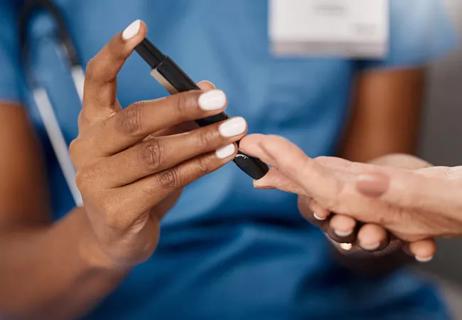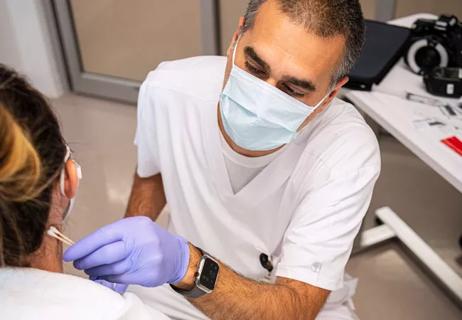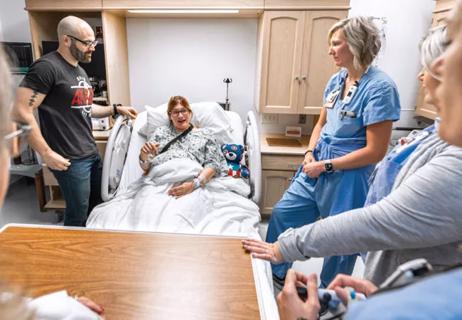Growing popularity of tattoos, piercings challenges nurses to set preconceptions aside

Preparing apprehensive patients to undergo MRI was nothing new for Christina Canfield, MSN, APRN, ACNS-BC, CCRN-E, but when a woman with more than 10 piercings was brought to the imaging room, the Cleveland Clinic nurse knew she was in uncharted territory. When the patient learned the ornaments would need to be removed, she tearfully explained that they held deep personal meaning and implored Canfield to do whatever she could to preserve her piercing tracts.
Cleveland Clinic is a non-profit academic medical center. Advertising on our site helps support our mission. We do not endorse non-Cleveland Clinic products or services. Policy
“I was struck by how important the piercings were to the patient, but I lacked the tools and knowledge needed to safely remove her jewelry and maintain her piercing sites,” she recalls. “For a long time, I was haunted by how unprepared I was to address her concerns.”
Determined to learn more, Canfield began to explore how to manage patients with body modifications – a growing concern for healthcare providers around the world. She and fellow Cleveland Clinic nurse Dianna Copley, DNP, APRN, ACCNS-AG, CCRN, recently presented some of their insights at the annual conference of the American Association of Critical Care Nurses National Teaching Institute.
Although body modifications can present a number of unexpected challenges for clinicians, the first – and perhaps most important – step in managing these patients is to set aside any preconceived notions, says Copley, a clinical nurse specialist in the surgical intensive care unit (ICU).
“We encourage nurses to do three things when approaching all patients, particularly those with body modifications: offer acceptance, remain open minded and ask questions,” she says.
One of the most prevalent biases is the assumption that people with tattoos or unusual piercings are more likely to engage in high-risk behaviors, notes Canfield, program manager in ICU Operations and eHospital ICU Telemedicine. Not only does that belief reinforce the perception that the patient may be to blame for their illness, it is a chief reason these patients are more often held accountable for the cost of their medical care, she explains.
Despite these negative stereotypes, however, studies show that individuals with body modifications are actually more likely to vote, participate in volunteer work, donate to charities and maintain a healthy body mass index than their peers.
Many people use tattoos and piercings to commemorate a meaningful life event or celebrate their ability to heal from trauma, which is all the more reason to regard these personal expressions with respect and sensitivity, explains Copley. For others, body modifications may have important cultural or religious significance.
“Some of these patients have incredible stories to tell, but you’ll miss them if you shut down conversation by making snap judgments,” she says.
There are, however, certain body modifications that may demand greater scrutiny. It is increasingly common for victims of human trafficking to be “branded” with tattoos to signify that they belong to their trafficker.
Although victims may have numerous tattoos on various areas of their body, locations commonly linked to human trafficking include the neck, arms and above the groin. In some cases, these tattoos may have a “homemade” appearance. Common red flags include tattoos that depict barcodes, initials coupled with a crown, and currency symbols (e.g., money bag, coins, or dollar bills).
Any interaction with a potential trafficking victim is a rare opportunity to offer potentially lifesaving intervention, says Canfield. “That’s why it is so essential to establish trust by demonstrating genuine concern and curiosity.”
Tattoos used by traffickers may vary by region, adds Copley, who suggests that clinicians consult with their local law enforcement agencies about markings that may be common in their area.
Nurses may also encounter patients who present with complications – infection, most commonly – after undergoing a piercing or tattoo. In such cases, it’s imperative to obtain a thorough medical history, including details about how and when the body modification was made, says Canfield.
Once again, she emphasizes the importance of offering encouragement and refraining from judgment. “These infections can sometimes progress very rapidly, so it’s important to make these patients feel comfortable about seeking medical care,” says Copley. “By the time a patient arrives, the modification has already happened. We can’t turn back the clock, but we can tell them how glad we are that they sought care.”
Nurses may also find themselves counseling patients with pre-existing conditions like diabetes or HIV who are interested in getting body modifications. Although safety is a justifiable concern in high-risk populations, Canfield encourages nurses to thoughtfully explore the patient’s questions before reflexively telling them to avoid these body modifications altogether.
“In many cases, the patient has already decided to pursue the piercing or tattoo, so fearmongering does them a disservice,” she says. “The most compassionate, practical thing we can do is help them navigate the safest way forward.”
If a nurse is unsure about how to handle a body modification, the first person they should talk to is the patient, says Copley. From gauges and barbells to surface-anchor screws and implants, the number of available body piercings continues to grow – which, she explains, is another reason nurses must rely on the expertise of their patients.
“The patient is the true authority on their body modification,” she says. “They can often provide the best guidance on how a piercing can be removed without damaging the jewelry or the patency of the piercing pathway.”
However, Copley cautions that piercing removal can cause significant stress for some patients and encourages clinicians to consider other possibilities before reaching for a hemostat. She also urges nurses to ask about the presence of piercings even if none are readily visible during the examination.
For additional guidance on the management of body modifications, Copley and Canfield suggest reviewing The Piercing Bible by Elayne Angel. Local body-modification artists can be another valuable source of education, they add.

Nurses play pivotal role in patients’ ability to recover in the comfort of their own homes

Advocating for patient safety is imperative in fast-paced surgical settings

Advice for those pursuing a WOC nursing career

Redesigned protocols enhance infection-prevention measures

Longevity in healthcare, personal experiences may provide caregivers with false sense of confidence

Specialized team prioritizes trauma-informed care and evidence collection

Collaborative approach leans on expertise of nurses

TeamBirth aims to improve outcomes by facilitating collaboration between patients and caregivers